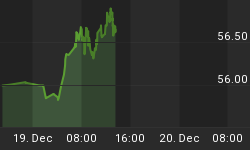Below is an extract from a commentary originally posted at www.speculative-investor.com on 13th January 2008.
Current Market Situation
A pullback should commence within the next few days, but the fact that the HUI has closed above its November-2007 peak suggests that significant additional gains will be achieved over the next couple of months.
If the magnitude of the current upward leg ends up matching the previous upward legs in the gold sector's long-term bull market then the HUI will peak at around 620 during the first half of this year. However, we don't think it's prudent to fixate on specific upside targets because the current upward leg has already deviated markedly from the pattern established during previous upward legs and could continue to do so. Instead, we should remain alert to the possibility that the current leg will peak at a much lower or a much higher level than predicted by the historical record.
On a longer-term basis the story is unfolding as per our expectations in that reduced financial market liquidity, emerging signs of economic weakness and a general shift away from risk evidenced by rising credit and yield spreads is causing gold to strengthen against almost everything (paper currencies, stock markets, bonds, and most commodities). However, we have been constantly frustrated over the past 5 months by the failure of most gold stocks to respond appropriately to the substantial strength in the bullion market. We have been especially frustrated by the lack of action at the junior end of the gold sector. These are the stocks that offer the greatest leverage to gold and should therefore have provided the greatest gains once it became clear that a major upward leg was in progress, and yet, with a few exceptions, they have done very little. For example, the gold resources of Gryphon Gold (TSX: GGN) are still being valued at only $20/ounce even though the company has made good progress on the ground; Gold-Ore Resources is still trading in the C$0.80s even though the 50,000-70,000 ounces of gold production that it will have by year-end should be worth a minimum of C$2/share with the gold price above $800; and Golden Queen Mining (TSX: GQM) is still trading in the C$0.80s even though the Feasibility Study published last month suggests that the C$2-C$3 range would be more reasonable.
The total absence of speculative froth at the small-cap end of the gold sector indicates that the public has not yet embraced the gold bull. It seems that hedge funds are responding to the gold rally by buying a few highly-liquid gold shares, but the general investing public -- the main driver of the smaller and less-liquid stocks -- remains unimpressed.
It's very unlikely that the gold sector's intermediate-term advance will end until after the small-caps have run hard, but we are beginning to wonder what gold will have to do to awaken the public's speculative urges.
Effect on the gold sector of a stock market meltdown
Whenever the broad stock market collapses the gold sector almost always gets dragged along for the ride. In fact, over the past 40 years the only stock market collapse that didn't bring about a large decline in the gold sector was the 5-day collapse in September of 2001. However, a steady decline in the broad stock market (as opposed to a collapse) can be very bullish for the gold sector.
1973-1974 provides us with a good example of the relationship between the gold sector and the broad stock market. As explained in last week's Interim Update, the broad stock market experienced a relentless, but choppy, decline from January of 1973 through to August of 1974, at which point the downward trend accelerated and there was a 2-month collapse. The gold sector trended relentlessly HIGHER from January of 1973 through to August of 1974; that is, it had a strong INVERSE correlation with the broad stock market during much of the devastating 1973-1974 equity bear. However, it collapsed along with the broad market during August-September of 1974 (the Barrons Gold Mining Index was cut in half within the space of about 4 weeks during August-September of 1974).
2000-2002 provides us with another good example in that the gold sector trended upward as the broad market trended downward until the broad stock market totally 'fell out of bed' during June-July of 2002. Once the broad stock market's relentless decline turned into a rout, the gold sector tanked (the HUI fell by 40% from its June-2002 peak to its July-2002 bottom, including a loss of 34% during the final 2.5 weeks of the decline).
Further to the above, if the broad stock market were to collapse at some point this year then the gold sector would probably not only collapse along with it but would suffer an even greater percentage decline. Note, though, that a stock market collapse does NOT appear to be a significant short-term risk. As mentioned earlier in today's report, the stock market will probably rebound over the next few weeks.















